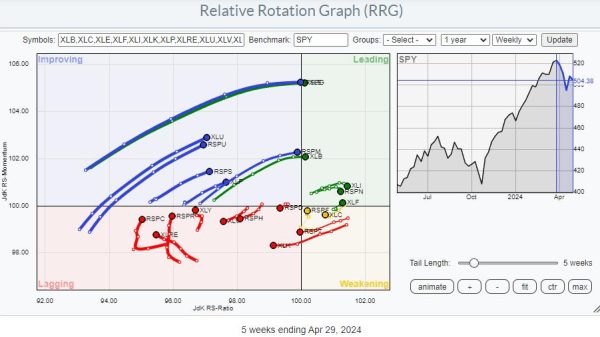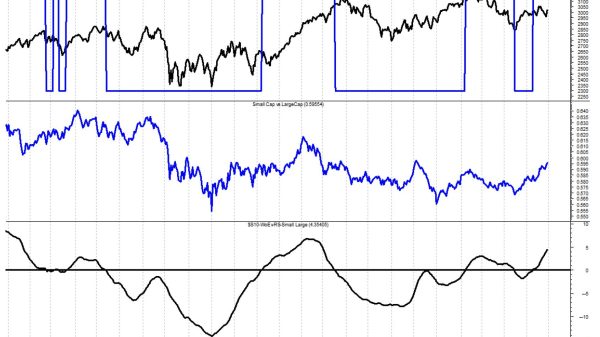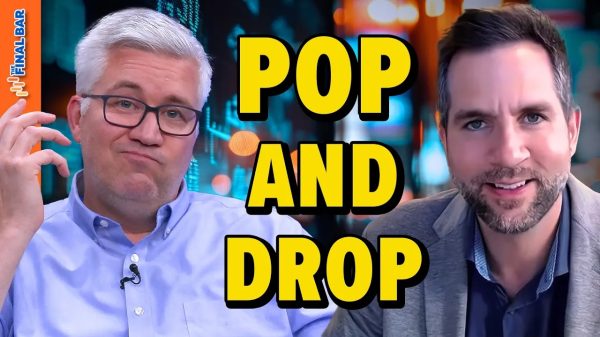Successful market timing relies on choosing the right market to time. In the StockChartsACP suite of Larry Williams plug-in indicators, three of them—Williams True Seasonal, Williams Money Flow Index, and Williams Sentiment Index—were designed with that purpose in mind. So now comes the timing part for entries and exits.
Before entering a market, the most basic questions you need to ask are:
Is the market in an uptrend or downtrend?Where should you buy or sell (or sell short)?Where should you place your stop loss?
Providing a visual answer to these questions is what Larry Williams’ WillTrend indicator is designed to do. Developed in 1988, WillTrend shows you whether a stock is trending and, if so, where, exactly, to enter a buy or sell.
How the WillTrend Indicator Works
This indicator is designed to work on weekly and daily charts only (sorry, intraday traders!). The signals and trend identification tools are remarkably clear and easy to understand. Take a look at the chart below.
CHART 1: DAILY CHART OF PROSHARES ULTRA BLOOMBERG CRUDE OIL ETF (UCO) AND WILLTREND INDICATOR. The WillTrend indicator clearly outlines the trending activity in UCO.Chart source: StockChartsACP. For educational purposes.
Looking at the daily chart of UCO, the picture is pretty clear. UCO broke out of a congestive area and began trending up. The WillTrend indicator correctly identified the trend action, although anyone who might have shorted UCO when prices fell below the WillTrend line might have gotten burned. But no indicator is perfect, and you have to consider the overall technical and fundamental context when engaging in any trade.
How to Apply the WillTrend Indicator in StockChartsACP
From Your Dashboard, click on the StockChartsACP button. Add a symbol in the symbol box and hit return. Under Chart Settings, scroll down to the Larry Williams Plug-Ins.Select Williams WillTrend.
How To Use the WillTrend Indicator
Looking at the description alone, you can probably guess how to put this indicator to use. Let’s look at the weekly chart for Intel Corp (INTC).
CHART 2: INTEL CORP. AND WILLTREND INDICATOR. Watch the patterns and breakouts as they unfold in relation to the WillTrend indicator.Chart source: StockChartsACP. For educational purposes.
Check out the following:
A— WillTrend was spot-on in identifying the beginning of INTC’s 15-month downtrend (a profitable ride for anyone who took that signal early on). When prices fell below the WillTrend line, the crossover signaled to go short INTC (of course, you do this with discretion). You would also place a stop loss above the WillTrend line, which served as an effective trailing stop.
B— INTC saw six months of congestion; if you had a stop loss above the WillTrend line, you would have remained in the trade. However, INTC was basing and no longer trending downward.
C— Prices crossed above the WillTrend line, triggering a buy signal and a trailing stop loss order below the WillTrend line.
This illustrates a trade where you could have remained in the market, first short and then long. Still, not all trading scenarios will be this “accommodative” to the indicator.
As effective an indicator as WillTrend can be in many cases, you still have to use your noggin when making trading decisions, such as in the daily chart of Apple, Inc. (AAPL) below.
CHART 3: AAPLE STOCK AND THE WILLTREND INDICATOR. The chart shows an uptrend punctuated by congestion periods. Trading during congestion periods can be tricky.Chart source: StockChartsACP. For educational purposes.
There are plenty of opportunities peppered with problematic pitfalls.
A— Congestion! Taking a trading signal within a congestion range will almost always spell trouble unless you have a compelling reason. In this case, you would have been whipsawed, and quite badly.
B— Nevertheless, an early entry signal off a risky V-bottom occurred shortly after congestion led prices downward. What might have made some traders nervous entering at this point were the layers of resistance up ahead.
C— The market response to this resistance caused traders to unload their positions (or sellers to enter theirs) as prices fell below the WillTrend line for three days. Would you have closed your long position or gone short at this level?
D— The uptrend resumes, and you can see several more buy points or opportunities to scale up your position as you rode the uptrend for several months. Needless to say, the market action that followed the March dip illustrates the most accommodating scenario for the WillTrend indicator.
E—Similar to A, the area designated as E marks another zone of congestion, much of it in response to the larger economic conditions surrounding the broader market. Do you go long, short, or hold off? When uncertainty strikes, or when buyers and sellers are in a temporary instance of equilibrium or agreement (with regard to valuations), you’ll want to hold off until further fundamental data or technical indications give a compelling case to take one position or another.
The WillTrend indicator can be effective in various market scenarios, but you must take a nuanced approach when analyzing your market and managing your trades. No indicator is perfect, but some are better than others in particular scenarios.
The Bottom Line
Larry Williams’ WillTrend indicator can be a valuable tool for identifying market trends and pinpointing entry and exit points. It’s designed to answer the basic (yet most actionable) questions: Is the market in an uptrend or downtrend? Where should you buy or sell or sell short? Where should you place your stop loss? However, as shown through various examples, while the WillTrend can be remarkably precise, it isn’t infallible. No indicator is. But if used wisely, the WillTrend can give you an edge particular to its design.























